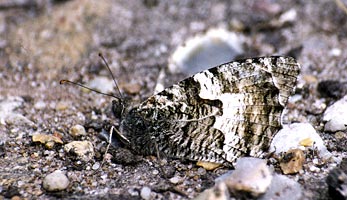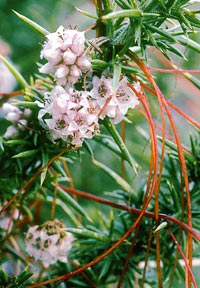| Norfolk is well-endowed with heathland. These were formed thousands of years ago on the dry sandy soils of the greensands in west Norfolk and on the sands and gravels dumped by ice-age glaciers in the north and east of the county. Although originally created by early farmers, probably some time in the Bronze Age, over the millennia these heaths have acquired a rich flora and fauna. |
 |
Adders, Slow Worms and Common Lizards are widespread and in the late summer the heaths are ablaze with the purples of Heather and Bell Heather and the vivid yellow of Western Gorse, while Graylings (left) flit on and off the paths, relying on their cryptic colouration for concealment. |
In the damper areas of heath the dusty grey foliage of Cross-leaved Heath appears and with it a different suite of species. In a very few places Lesser Butterfly Orchid and Marsh Gentian can still be found and there are some thriving colonies of Silver-studded Blue butterflies and Bog Bush-cricket. Bog Bush-cricket |
 |
 |
In the most favoured heathland valleys there are some superb boggy 'valley mires'. These are formed where water comes to the surface after percolating, perhaps for years, through the acid sands and gravels of the surrounding heaths. These bogs or 'mires' support localised dragonflies such as Black Darter and Keeled Skimmer, as well as a host of interesting plants, including sundews and butterworts. Keeled Skimmer |
Elsewhere in the county there are small areas of fenland that are more calcarious in nature and these are equally fascinating, holding a whole range of different species, including up to three orchid specialities: Marsh Helleborine, Marsh Fragrant Orchid and Pugsley’s (or Narrow-leaved) Marsh Orchid (see the Wild Orchids gallery). And, almost unique to Norfolk, there are fascinating ‘mixed mires’, where acid and alkaline conditions, together with their respective plants and animals, can be found side-by-side. These mixed mires are found on a few heathlands, and can easily fill up an entire day's exploration. Common Dodder |
 |


